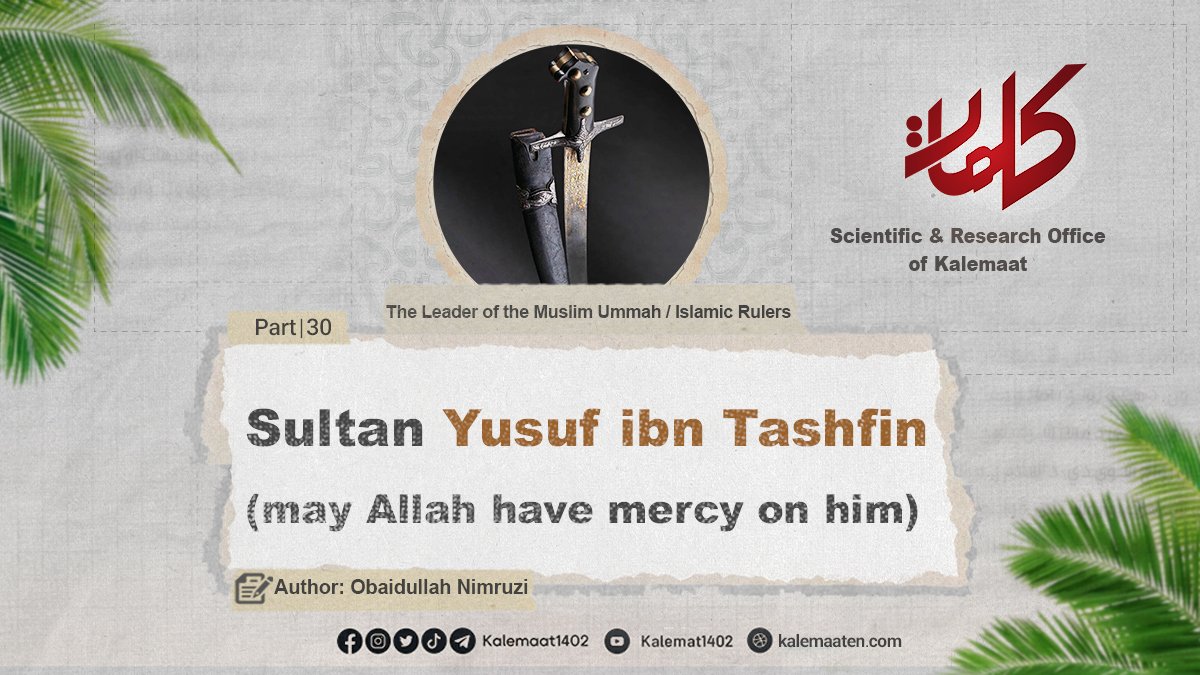
Author: Obaidullah Nimruzi
The Guardian of al-Andalus (Spain): Sultan Yusuf ibn Tashfin [MABH] (Part 30)
The Birth of Marrakesh; A Capital Born of Jihad and Planning
From the year 454 AH, the power of Yusuf ibn Tashfin increased in the Maghreb and the foundations of his government were strengthened in that land. As a result, his army expanded greatly and he seriously needed a permanent headquarters that would be both a base for jihad and a safe haven for the mujahideen. His motivation was to build a new city for the capital of the Almoravid state; because several factors led him to this decision, the most important of which are the following:
Aghmat; a city that no longer had capacity
First, the lack of sufficient space in the city of Aghmat for the Almoravids to reside and its residents complained about the crowding and congestion, because the Almoravids were a nomadic people and were not accustomed to urban life and living in closed environments. In addition, the livestock they brought with them also needed extensive pastures and open lands.
The Dream of a Fortress for the Mujahideen
Second, the Almoravids wanted to have a dedicated fortress that would house both themselves and their army and be the base for their future military plans, a place that was in keeping with their great aspirations.
Disagreements in the Date of the Construction of Marrakesh
Although there are differences in the sources [1] regarding the year when the construction of the city of Marrakesh began, I think 454 AH is the most likely option, because the city of Aghmat could no longer accommodate so many mujahideen and volunteers. Yusuf ibn Tashfin was forced to draw a map of a new city called Marrakesh and, at the very beginning, settle in that area by pitching a tent and personally begin its construction. [2] And historically, it is unlikely that the city of Aghmat could have accommodated this large population after 462 AH.
Why this location? A smart choice
The location of the city of Marrakesh was also determined by a group of elders from the “Hailana” and “Husmeira” tribes, residents of Aghmat. This group chose an open, vast, desert land that had special characteristics: on one side it reached the lush and fertile plains of Doukkala, and on the other, the Nafis Valley and its gardens, as well as the mountains that shaded the area like a protective wall. [3]
A land in harmony with the spirit of the Almoravids
This area was in harmony with the desert temperament of the Almoravids and provided good pasture for their camels and livestock. It is also possible that Emir Abu Bakr ibn Omar participated in all stages of the establishment of this city and played a role in its initial decisions. [4]
The great founder; Yusuf ibn Tashfin
However, the real founder of the city of Marrakesh was none other than Youssef ibn Tashfin. It was he who completed the construction, built a mosque in it, created treasury and weapons depots, and even during the construction of the mosque, he himself got down to business and picked up mud and bricks with the workers, working humbly for the sake of Allah. [5]
The secret of the name “Marrakesh”
The name “Marrakesh” is also derived from the name of the same region where the city was built. This word means “I go in a hurry” in the local language. [6] Since that area was previously a place of traffic for bandits and thieves, those who passed by would say to their companions: “Marrakesh!” meaning: “Get going quickly!” And this name stuck to the region.
From waterlessness to settlement
At that time, there was no water there, but people dug wells and soon reached water. Marrakesh remained without walls until the time of Ali ibn Yusuf (son of Yusuf ibn Tashfin), until around 526 AH, a wall was built around it at the suggestion of Judge Abu al-Walid Muhammad ibn Rushd (a famous jurist). [7]
A Qibla for Science and Struggle
Marrakesh gradually became the powerful capital of one of the greatest states founded on piety. This city saved the Western Islamic world from destruction, transformed its dispersion into unity, and repaired its ruins. Marrakesh became a Qibla for scholars, students of science, and lovers of literature; because the mujahids established security and stability in it, and from this stability, a genuine and advanced civilization grew.
Conclusion of the topic!
The unification of the Maghreb lands in the Middle Ages, in a context filled with scattered tribes, diverse cultures, and a difficult and sometimes hostile geography, is considered an extraordinary and noteworthy phenomenon in the history of Islam. An examination of the roots of this unity and its shaping elements, especially during the Almoravid period, shows that several factors came together to institutionalize this unity, not only at the military and political levels, but also in cultural, religious, civilizational, and even identity dimensions.
At first glance, it may seem that the unification of the Maghreb was only the result of the Almoravid military power and their repeated victories, but a closer examination of the developments of this period shows that deeper elements were at work; elements such as religious faith, the call to the prophetic Sunnah, reformist discourse, the role of immigrant scholars, and the prudent management of the mujahid leaders. This complex combination of religious motivations and political necessities brought together lands such as Sousse, Aghmat, Fez, Tlemcen, Ceuta, Tahrir, and even Andalusia under a single banner.
From the perspective of historical sociology, the Almoravid state can be considered a unique example of a religious-military state that succeeded in creating a kind of synergy between Berber and Arab tribes, nomadic and urban traditions, and diverse Maghrebi and Andalusian cultures. This state was able to make a single language for religious and cultural interactions – the language of the Quran and Hadith – prevail over tribal and ethnic differences.
Geographically, the Maghreb region was also one of the most difficult lands in the Islamic world: the Atlas Mountains, vast deserts, uninhabited plains, and isolated ports were all serious obstacles to unity. But the Almoravid jihad, along with the establishment of strategic centers such as the city of Marrakesh, showed how, relying on faith and prudence, these natural obstacles could be turned into civilization-building opportunities. Marrakesh became not only a political capital, but also a hub for education, the dissemination of Sharia sciences, the organization of jihad, and the spread of Islamic identity throughout the Maghreb.
The important point is that the unification of the Maghreb did not stop at geographical borders. What happened during the Almoravid era was a kind of civilizational solidarity that was formed on the basis of Islamic law, Sunni principles, and a global view of the Muslim Ummah. For this reason, the impact of this unity went beyond the Maghreb and extended to Andalusia, Nigeria, the Sahara Desert, and even, in the long term, to present-day Morocco and the Arab Maghreb.
In conclusion, it must be said that the unification of the Maghreb is a successful and inspiring experience of the connection of religion, politics, and jihad on the path of civilization-building. This experience, despite all the challenges, was a concrete example of the realization of a “single Ummah” in a corner of the Islamic world. And today, in a world where the Islamic world is once again faced with various divisions, rereading this historical experience can open new horizons for unity, solidarity, and the reconstruction of Islamic identity.
Continues…
References:
- Al-Halal Al-Mushiya, p. 5; Ibn Azari, Al-Bayan Al-Maghrib, 4/20; Ibn Abi Zarh, Rawzat al-Qartas, p. 89; Ibn Khaldun, History, 6/186; Al-Salawi, Al-Iqtisasa, 2/24.
- Ibn Khaldun, History, 6/184.
- Al-Halal Al-Mushiya, p. 16; Publisher: Dar Al-Thaqafa, Beirut, 1983 AD.
- Ibid.
- Ibn Abi Zarh’, Rawzat al-Qartas, p. 89; Al-Salawi, Al-Iqtisasa, 2/25.
- Ibn Khalakan, Wafiyat Al-Ahyan, 7/124.
- Moghafar al-Barbar, p. 53; Publisher: Darul Kitab, Tetovan, 1999.



